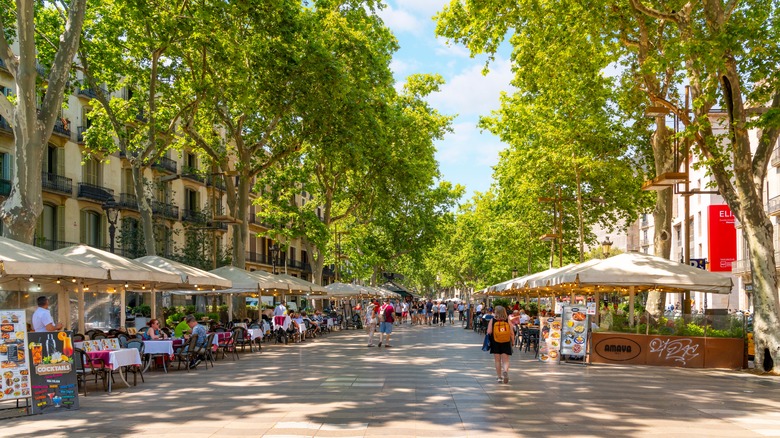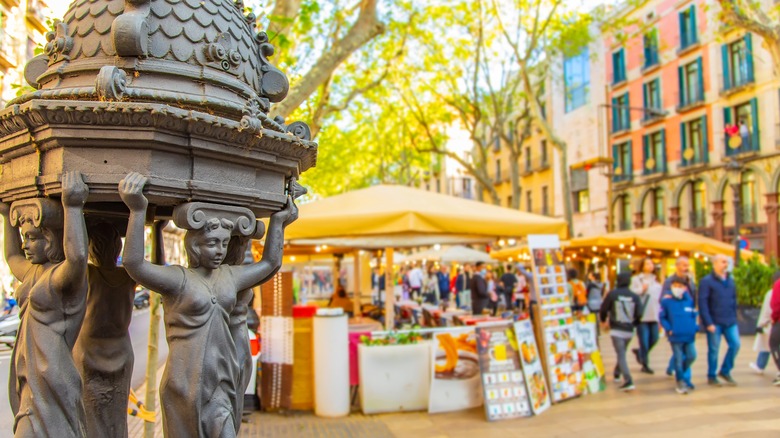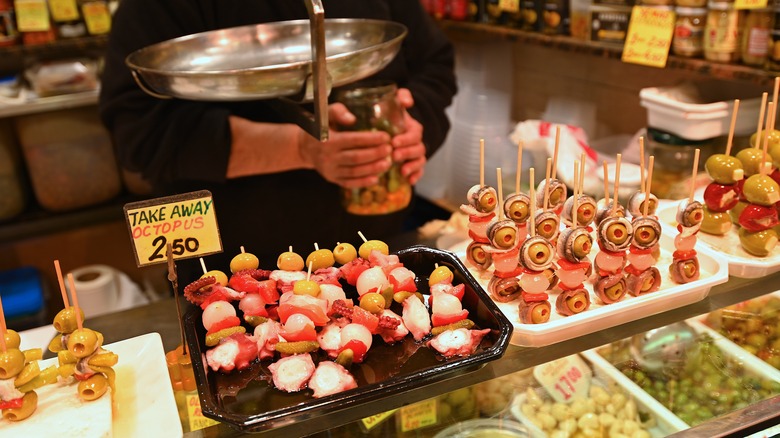The Beautiful And Bustling Street In Barcelona Tourists Should Avoid Eating At
La Rambla, Barcelona's tourist spine, is part Picadilly Circus, part Champs d'Elysee, and part Bourbon Street. What it's not, unless you don't mind blowing the budget, is a great place to eat. Almost every visit to Barcelona includes a stroll on La Rambla (also called "Las Ramblas" because it's a succession of several streets, each with Rambla in the name: Rambla de Canaletes, Rambla dels Estudis, Rambla de les Flors, Rambla dels Caputxins, Rambla de Santa Mònica and Rambla del Mar).
The bustling strip stretches ¾ miles from Port Vell to Plaça Catalunya, with distinctive vibes on each rambla. Plaça Catalunya is a lively square with fountains, street performers, and a few spots to sit and watch the action. Following south and a little east, the street is lined with shops and plenty of souvenir kiosks and stores, including the Barça Store with everything the FC Barcelona fan could want, even occasional appearances by Barça players.
Continue along the pedestrian-friendly street, which has a broad walkway down the middle and a narrow lane for cars on either side, taking in the throngs of sun-kissed folks, but keep an eye out for pickpockets — save yourself some hassle and don't bring a backpack. At the end of La Rambla, approaching the port, things get a bit "colorful," especially at night, when the area serves as a red-light district. La Rambla is definitely worth a visit, but we still wouldn't plan to eat there.
Food on La Rambla is expensive
The price is the number one reason to avoid eating on the busy street. Barcelona isn't a cheap destination to begin with, but the prices on La Rambla range from "ouch" to eye-watering. For example, a glass of Coke (which rings in around €2.50 in an average Barcelona restaurant) can be priced at €10 on the busy tourist stroll. On a r/Barcelona thread, one Redditor advises, "Any restaurant in the main street of Las Ramblas is not worth it and you will pay 15 euro for a bad sangria."
The other complaint against La Rambla eateries is that they just aren't that good. While some may be okay with blowing their budget on a truly excellent meal (it's actually one of the few splurges budget-wise travel guru Rick Steves recommends), paying an exorbitant amount for a mediocre meal is a sure way to leave a nasty taste in your mouth. The restaurants know tourists will come regardless of price, and on La Rambla, the location is the big draw, rather than the chance to experience top Catalan cuisine. There are some exceptions, of course, but in general, know that if you eat on La Rambla, you are not getting the best of Barcelona.
What to do on La Rambla instead
Barcelona can hardly be called a little-known European foodie destination. Catalan regional specialties abound, from simple tomato and olive oil on rustic bread to rice dishes made with black squid ink. The Fork is an invaluable app for restaurant reviews in Europe and can help you find top-notch eats in the rest of the city. Several metro lines service La Rambla, so finding your way to a highly regarded restaurant after your ramble on La Rambla is incredibly easy. Top-rated restaurants that aren't too far out of the way include Fonda España by Martín Berasategui in the Hotel España, L'Antiquari Gastronòmic, and Moments in the Mandarin Oriental, which has earned an impressive two Michelin stars.
If, despite the warnings, you choose to have a meal on La Rambla, we have a few ideas to save you from the tourist traps. Barcelona insiders give the nod to Cafe l'Opera for its ambiance and Ultramarinos for quality food at fair prices. There is also a Carrefour supermarket on Rambla dels Estudis with some ready-made food from which you can create your own picnic. But the key tip to eating on La Rambla is La Boquería. The celebrated market houses dozens of food vendors. Pick and choose a few tasty tapas and things to try. It isn't a sit-down dining experience, but if you need some sustenance, it's your best bet on a street with few options.


